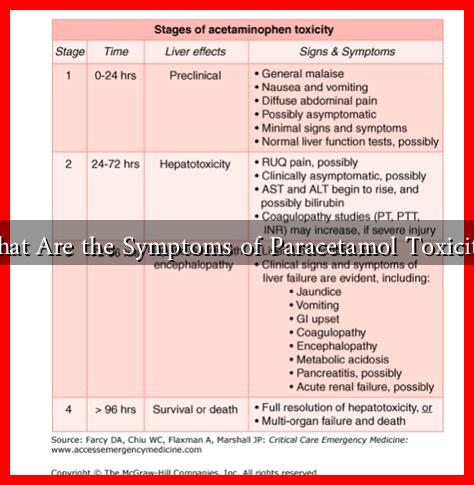-
Table of Contents
- What Are the Symptoms of Paracetamol Toxicity?
- Understanding Paracetamol and Its Uses
- What Causes Paracetamol Toxicity?
- Symptoms of Paracetamol Toxicity
- Stage 1: Initial Symptoms (0-24 hours)
- Stage 2: Latent Phase (24-72 hours)
- Stage 3: Severe Liver Damage (72-96 hours)
- Case Studies and Statistics
- Conclusion
What Are the Symptoms of Paracetamol Toxicity?
Paracetamol, also known as acetaminophen, is one of the most commonly used over-the-counter medications for pain relief and fever reduction. While it is generally safe when taken as directed, an overdose can lead to severe toxicity and potentially fatal consequences. Understanding the symptoms of paracetamol toxicity is crucial for timely intervention and treatment.
Understanding Paracetamol and Its Uses
Paracetamol is widely used for various conditions, including:
- Headaches
- Muscle aches
- Arthritis
- Backaches
- Toothaches
- Colds and fevers
Despite its effectiveness, paracetamol is not without risks. The therapeutic dose for adults is typically 500 mg to 1000 mg every four to six hours, with a maximum daily limit of 4000 mg. Exceeding this limit can lead to toxicity.
What Causes Paracetamol Toxicity?
Paracetamol toxicity primarily occurs when the liver is overwhelmed by excessive amounts of the drug. The liver metabolizes paracetamol into non-toxic substances, but in high doses, it produces a harmful metabolite called N-acetyl-p-benzoquinone imine (NAPQI). This metabolite can cause liver damage and failure if not neutralized by glutathione, a natural antioxidant.
Symptoms of Paracetamol Toxicity
The symptoms of paracetamol toxicity can be categorized into three stages, each with distinct signs and symptoms:
Stage 1: Initial Symptoms (0-24 hours)
During the first 24 hours after ingestion, symptoms may be mild and easily overlooked. Common initial symptoms include:
- Nausea
- Vomiting
- Loss of appetite
- Fatigue
- Abdominal pain (especially in the upper right quadrant)
Stage 2: Latent Phase (24-72 hours)
After the initial symptoms, there may be a brief period of improvement, but this does not indicate recovery. During this latent phase, the liver damage progresses, and symptoms may include:
- Right upper quadrant pain
- Jaundice (yellowing of the skin and eyes)
- Dark urine
- Pale stools
- Confusion or altered mental status
Stage 3: Severe Liver Damage (72-96 hours)
If left untreated, paracetamol toxicity can lead to severe liver failure, which may manifest as:
- Severe abdominal pain
- Profuse bleeding or bruising
- Encephalopathy (confusion, drowsiness, or coma)
- Multi-organ failure
- Death
Case Studies and Statistics
According to the American Association of Poison Control Centers, paracetamol is one of the leading causes of acute liver failure in the United States. In a study published in the journal *Hepatology*, it was found that approximately 50% of liver failure cases were attributed to paracetamol overdose. This highlights the importance of recognizing the symptoms early and seeking medical attention.
In one notable case, a 30-year-old woman ingested 20 grams of paracetamol in a suicide attempt. Initially, she presented with nausea and vomiting, but within 48 hours, she developed severe liver failure requiring a transplant. This case underscores the critical need for awareness regarding the risks associated with paracetamol overdose.
Conclusion
Paracetamol is a widely used medication that can be safe and effective when taken as directed. However, overdose can lead to severe toxicity with potentially fatal consequences. Recognizing the symptoms of paracetamol toxicity—ranging from mild nausea to severe liver damage—is essential for timely intervention. If you suspect an overdose, it is crucial to seek medical help immediately. For more information on paracetamol toxicity and treatment options, you can visit the American Association of Poison Control Centers.
In summary, understanding the symptoms and stages of paracetamol toxicity can save lives. Always adhere to recommended dosages and consult a healthcare professional if you have any concerns regarding paracetamol use.

